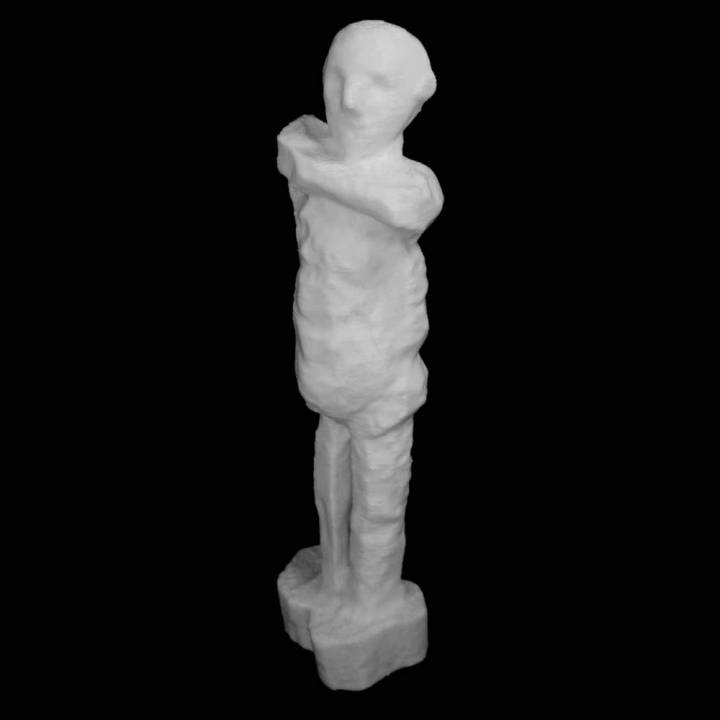
Reklama
3D tiskárny



AONN.cz
Sp┼Ö├ítelen├ę Weby
|
3D modely ARTUntitled 1982-3 at Tate Modern, London

Title Untitled Artist George Baselitz Date 1982- 3 Medium Limewood Dimensions 2500 x 730x 590mm, 210kg Accession# T06729 Credit Acquired by purchase and gift from Hartmut and Silvia Ackermeier, Berlin 1993 Untitled 1982–3 is a monumental figurative sculpture by the German artist Georg Baselitz made from roughly hewn limewood. At two and a half metres tall, the figure, whose legs seem trapped within the wooden base, towers high above the viewer. The figure may be male or female, and stands with its left arm across the top of its chest, so that its left hand rests on its right shoulder. Crudely applied brushstrokes of blue and black paint appear on the figure’s torso and left leg, and more extensive streaks of blue outline the face, which is largely expressionless. The tactility of the sculpture and its raw materiality are emphasised by the rough marks left by Baselitz’s tools: the deep crevices and rugged indentations, particularly evident in the figure’s legs, its swollen stomach and its arms, highlight the sculptural process as well as imbuing the figure with a primal or totem-like appearance. Untitled was made in Baselitz’s studio in Schloss Derneburg, a castle near the city of Hildesheim in northern Germany that the artist bought in 1975 and in which he lived until 2006. Having worked primarily as a painter since the 1950s, Baselitz began creating sculptures in 1979. His first sculptural work, Model for a Sculpture 1979–80 (Museum Ludwig, Cologne), is a reclining paint-daubed wooden figure with an outstretched arm and was the only work displayed in the German Pavilion at the Venice Biennale in 1980. From late 1982 and for a year thereafter Baselitz produced a series of eight sculptures, consisting of five standing figures – including this work – and three large heads. Like Untitled, the other four standing figures in this series display ambiguous gestures with their arms, which the artist described in 1983 as ‘extreme postures that look abstract, that are highly artistic, are highly charged with meaning, but are never thought through. Everyone knows how powerful they can be’ (quoted in Gretenkort 2010, p.71). Preparatory drawings reveal that Baselitz carved these sculptures directly from tree trunks, often using chainsaws and axes. He claimed in 1983 that he worked with wood because he wanted ‘to avoid all manual dexterity, all elegance, everything to do with construction’ (quoted in Gretenkort 2010, p.74). The art historian Andreas Franzke has argued that Untitled ‘is covered with crude, unprofessional-looking cuts, which point to a brutal assault on the material rather than a well-tempered process’, and he suggests further that Baselitz ‘deliberately courts sudden losses of control and damage to the figures’ (Franzke 1989, p.182). Untitled may also be seen in relation to the artist’s interest in African sculpture, of which he has built up a large collection, claiming that ‘African sculpture is also our past, also mine, here in Northern Europe’ (quoted in Kraus 2009, p.28). The rough-shaped figures in Baselitz’s sculptures may be compared with the wounded subjects that often appear in his paintings, woodcuts and drawings (see, for example, Rebel 1965, TateT03442). The damaged landscapes and deformed humans in his work have been associated with the Neue Wilden (‘new wild’) movement, a term used to describe German artists of the 1970s and 1980s, including Anselm Kiefer, who utilised large canvases, expressive brushwork, bold colours and a range of figurative forms. (Credit; Tate) n├íhodn├Ż v├Żb─Ťr model┼»
|
©Ofrii 2012
| |||